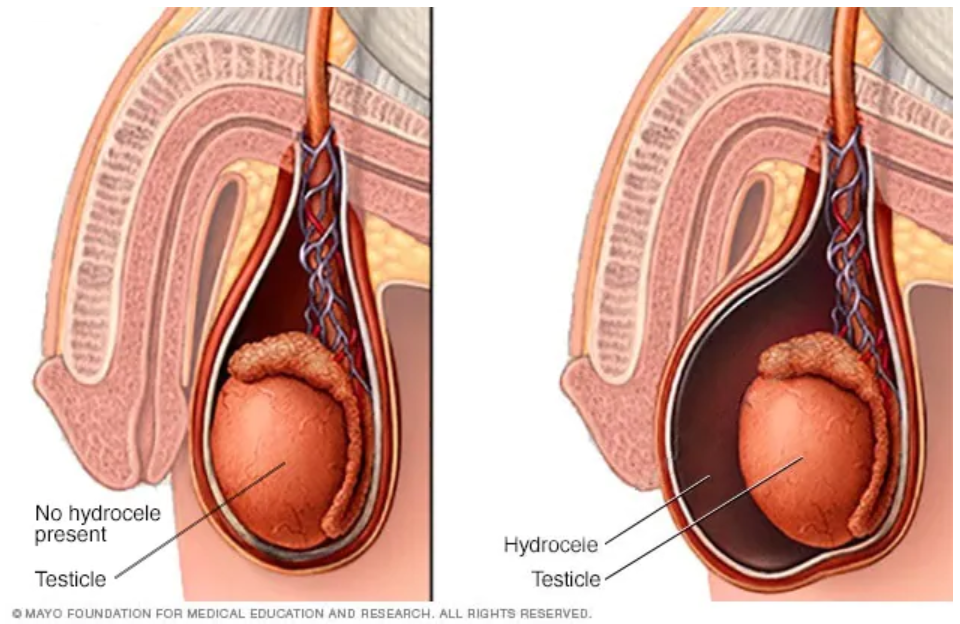Treatments Sexual Wellness Hydrocoele

Understanding Hydrocele: Causes, Symptoms, and Treatment Options
A hydrocele occurs when there is an imbalance in the production and absorption of fluid within the scrotum. Normally, the body produces a small amount of fluid to lubricate the space around the testicles. This fluid is then reabsorbed into the bloodstream. However, when this balance is disrupted, excess fluid can accumulate, leading to the formation of a hydrocele.
Hydrocele is a common medical condition that affects males, typically presenting as the accumulation of fluid around the testicles. It is estimated that hydroceles affect about 1 to 2 percent of adult men worldwide, with an even higher incidence in infants. Although hydroceles are generally harmless and non-threatening, they can cause discomfort and warrant medical attention. In this article, we will explore the causes, symptoms, and treatment options for hydrocele.
Causes
A hydrocele occurs when there is an imbalance in the production and absorption of fluid within the scrotum. Normally, the body produces a small amount of fluid to lubricate the space around the testicles. This fluid is then reabsorbed into the bloodstream. However, when this balance is disrupted, excess fluid can accumulate, leading to the formation of a hydrocele.
In newborns, hydroceles often develop due to the incomplete closure of the connection between the abdomen and the scrotum, known as the processus vaginalis. This connection normally closes before birth, but in some cases, it remains open, allowing fluid to accumulate. In adults, hydroceles can be caused by a variety of factors, including inflammation, injury, infection, or tumors in the scrotum.
Symptoms
The most common symptom of a hydrocele is the presence of a painless, swollen scrotum. The swelling is typically smooth and can vary in size. In some cases, the hydrocele may only be noticeable when the affected individual is standing, while it may appear smaller or disappear when lying down. The size of the hydrocele may fluctuate throughout the day, depending on the amount of fluid accumulation.
Although hydroceles are usually painless, they can cause discomfort due to the increased weight and size of the scrotum. In some cases, the swelling may lead to pressure on the testicles, resulting in a dull ache or heaviness in the groin area. If the hydrocele becomes infected, symptoms such as redness, warmth, and tenderness may occur.
Treatment Options
In many cases, hydroceles in newborns resolve on their own within the first year of life. However, if the hydrocele persists or becomes larger, a paediatric urologist may recommend a surgical procedure called a hydrocelectomy to remove the excess fluid and close the connection between the abdomen and scrotum.
In adults, the treatment approach depends on the underlying cause of the hydrocele and the severity of symptoms. If the hydrocele is small and painless, watchful waiting may be recommended, with regular monitoring to ensure it does not worsen or become infected. However, if the hydrocele causes discomfort or is significantly affecting the individual’s quality of life, surgical intervention may be necessary.
The most common surgical procedure for hydrocele in adults is a hydrocelectomy. This procedure involves making a small incision in the scrotum to drain the fluid and remove the hydrocele sac. In some cases, the surgeon may opt for a different technique, such as aspiration or sclerotherapy, where a needle is used to drain the fluid and a medication is injected to promote the closure of the sac.
Role of Homeopathy
Homeopathy treats each person as a unique individual, considering not only their physical symptoms but also their mental and emotional state. The selection of a homeopathic remedy is based on the principle of “like cures like,” where a substance that can produce symptoms in a healthy person is used to stimulate the body’s self-healing response in someone experiencing similar symptoms. At Dr. Singh’s Homeopathy; we prepare treatment plan according to symptoms of patient as symptoms can vary in every case. If you or your known are experiencing the above-mentioned symptoms feel free to contact Dr. Singh’s Homeopathy.
Complementary Lifestyle Recommendations
In addition to homeopathic remedies, certain lifestyle modifications can complement the treatment of hydrocele:
Conclusion
Hydroceles are relatively common and usually benign conditions characterized by the accumulation of fluid around the testicles. While they often resolve on their own in newborns, medical attention may be required if the hydrocele persists or causes discomfort. In adults, treatment options vary depending on the severity of symptoms and underlying causes. If you suspect you have a hydrocele or are experiencing any related symptoms, it is advisable to consult Dr. Singh’s Homeopathy for an accurate diagnosis and appropriate treatment.

